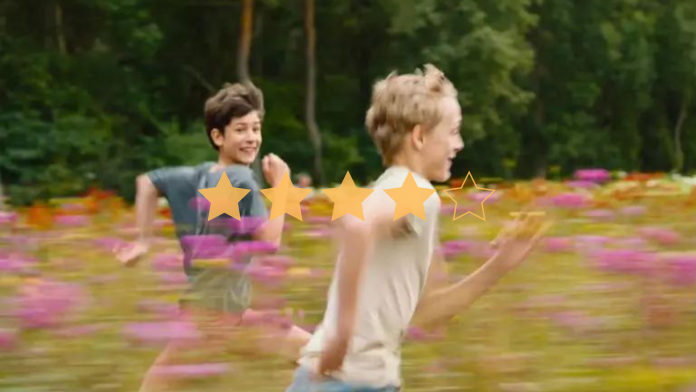Director Lukas Dhont follows up his debut feature Girl (2018) with an intimate portrayal of two 13-year-old boys, Léo and Rémi, and the friendship, love and loss they experience when their childhood innocence is challenged.
★★★★✰
Inspired by Dhont’s reflection on his early relationships and identity, Close shows us how destructive social norms can be to who we are and how we behave. In coming-of-age stories, especially those that deal with queer identities, we’re accustomed to seeing struggle painted as an innate part of the queer experience. Close, however, contests this narrative. Through the idyllic and romantic opening scenes that see Léo and Rémi carefree, playing through sunkissed rural Belgium flower fields, we’re given a glimpse into a world free from the pressures of adolescence. This is not a coming-of-age film that celebrates the necessity of struggle for growth, but rather leaves us longing for a more accepting and gentler world where those who defy expectations are not fighting an uphill battle.
Léo and Rémi are blessed with a beautiful and caring friendship and accepting families who cast no judgement on their intimacy as they play together and share a bed. Rémi is the quieter of the two, happy to be comforted and swept up by Léo’s imagination. Watching on with admiration as Rémi practises playing the oboe, Léo confidently declares plans for a future in which he will manage Rémi’s musical career, “travel the world, even the moon, and become filthy rich”. This youthful naivety, and hope for what possibilities the world might offer them, is quickly dimmed when the boys start middle school and are challenged by other students about their close friendship. In the face of this confrontation, the boys, for the first time, begin to prioritise how they are perceived over their own happiness.
The story takes place in a small world, mostly the boys’ rural homes and their school. Many sequences see them travelling between these locations. They stay in focus while running, on bikes or in cars, with the world behind them blurred. Whether they are running from something, toward something, or catching their breath somewhere in between, Dhont never lets them stay static for too long. We see the transitional nature of their lives reflected in constant movement, as they waver between childhood and adolescence.
With so little given away in the minimal and often superficial dialogue, the performances, especially those of Eden Dambrine (Léo), Gustav De Waele (Rémi) and Émilie Dequenne (Sophie, Rémi’s mother), are at their most powerful in the quietest moments of the film. Intimacy is created in the gazes of admiration and care between these characters. At more turbulent points, we see the deep sadness and desperation for connection held back from the dialogue, revealed through subtle glances and movements. These accomplished performances, especially impressive from newly discovered actors Dambrine and De Waele, let us into the difficulty of putting words to feelings trapped just below the surface.
Alongside these tender performances, Dhont successfully employs light, colour, music and sound to bring emotions to the forefront. Whilst the story exists in a small space, the locations that become familiar feel vastly different as Léo and Rémi drift apart and the joy we see in the early scenes is replaced by hurt. The warm sunlight that the boys bask in shifts into colder tones when spending time at school, where they first encounter hostility. This is especially evident in scenes of Léo’s newfound pursuit of ice hockey, allowing him to put a masculine mask between himself and his new reality. Similarly, the soundscape of tweeting birds, gentle breeze and Valentin Hadjadj’s soaring score is replaced with barking dogs, frantic playground arguments and thundering rain in moments of turmoil.
At points, these parallels are in danger of being too overt. Several scenes are mirrored with new sombre tones in the midst of conflict, ensuring the audience are repeatedly reminded of the loss of beauty, warmth and joy when the harshness of the world creeps in. In an early scene we see Rémi play his oboe at a school concert, his solo melody sitting above the orchestral accompaniment in a room filled with sunlight. A later comparative scene, without Rémi present, sits in the gloomy shadow of the first, with despondent distance between the characters. Throughout Close we’re constantly reminded of the pain caused by the repression of identity, not just for the individuals we follow, but the world itself.
This focus on emotion is undoubtedly at the centre of the film, with the narrative just one tool employed to pull its audience in. In its 105-minute duration, some narrative points are simplified in order to devote more time to what Close does so powerfully; capturing the cruel experience of having the beauty and optimism of childhood ripped away. Heartbreaking but not without hope, Dhont shows us that if we can learn to accept and understand each other and ourselves, we can find light and warmth in the world again.
The Verdict
Through powerful performances, a moving score and vivid colour, Close successfully opens up the small world of Léo and Rémi on their poignant journey from childhood to adolescence, beautifully capturing both their peace and their pain.
Words by Lena Moss
Support The Indiependent
We’re trying to raise £200 a month to help cover our operational costs. This includes our ‘Writer of the Month’ awards, where we recognise the amazing work produced by our contributor team. If you’ve enjoyed reading our site, we’d really appreciate it if you could donate to The Indiependent. Whether you can give £1 or £10, you’d be making a huge difference to our small team.
